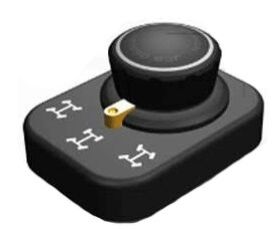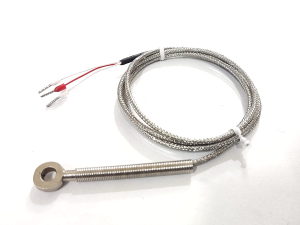
Temperature Sensors
Get Price Quote
We deal in wide range of Temperature Sensors. Right from RTD Sensors and Flexible Thermocouple Wire Sensors, we make available all types of Temperature Sensors. We have updated fabrication facility to come up with Temperature Sensors in different technical specifications. All the accessories are specifically tested for resistance to corrosion, moisture and likewise climatic conditions. Also, they comply with ANSI standards. We believe in offering the best value for money and this makes us a sought-after name as Temperature Sensors Manufacturer, Exporter and Supplier from Haryana. What are the different thermocouple types?A thermocouple is available in different combinations of metals. The four most common calibrations are J, K, T and E. There are high temperature calibrations R, S, and B. Each calibration has a different temperature range and environment, although the maximum temperature varies with the diameter of the wire used in the thermocouple. Although the thermocouple calibration dictates the temperature range, the maximum range is also limited by the diameter of the thermocouple wire. That is, a very thin thermocouple may not reach the full temperature range. How to select a thermocouple type? Because a thermocouple measures in wide temperature ranges and can be relatively rugged, thermocouples are very often used in industry. The following criteria are used in selecting a thermocouple : Temperature range Chemical resistance of the thermocouple or sheath material Installation requirements (may need to be compatible with existing equipment; existing holes may determine probe diameter) How to select a junction type? Sheathed thermocouple probes are available with one of three junction types; grounded, ungrounded or exposed. At the tip of a grounded junction probe, the thermocouple wires are physically attached to the inside of the probe wall. This results in good heat transfer from the outside, through the probe wall to the thermocouple junction. In an ungrounded probe, the thermocouple junction is detached from the probe wall. Response time is slower than the grounded style, but the ungrounded offers electrical isolation. Thermocouple in the exposed junction style protrudes out of the tip of the sheath and is exposed to the surrounding environment. This type offers the best response time, but is limited in use to dry, non-corrosive and non-pressurized applications. Types : A grounded junction is recommended for the measurement of static or flowing corrosive gas and liquid temperatures and for high-pressure applications. The junction of a grounded thermocouple is welded to the protective sheath, giving faster response than the ungrounded junction type. An ungrounded junction is recommended for measurements in corrosive environments where it is desirable to have the thermocouple electronically isolated from and shielded by the sheath. The welded wire thermocouple is physically insulated from the thermocouple sheath by MgO powder (soft). An exposed junction is recommended for the measurement of static or flowing non-corrosive gas temperatures where fast response time is required. The junction extends beyond the protective metallic sheath to give accurate fast response. The sheath insulation is sealed where the junction extends to prevent penetration of moisture or gas which could cause errors. Factors to Consider : Choosing the correct thermocouple requires that you look at a number of factors. For example, a thermocouple, which is used only periodically, may be less expensive, but it may have a shorter life span and require servicing more often. If the thermocouple is intended to be used for long periods without service, it may be necessary to use a thicker gauge of wire and it may be necessary to use a design engineered for a greater degree of protection. Below are some general guidelines to consider when choosing a thermocouple. If you need more help making a decision our knowledgeable sales staff is available to recommend a design which will best suit your application. What are the maximum and minimum temperatures the thermocouple will see? What error tolerances are necessary for your application? What is the Measuring atmosphere?(Corrosive/abrasive/vibrating etc) What is the time response required? Will the thermocouple be used continuously or periodically? Will the thermocouple see bending or flexing during it's life? What is the immersion depth? General Guidelines : Do not allow excessive bending of the thermocouples. Cold working can lower the insulation resistance at certain points causing short circuits or decreased accuracy. Use protection tubes for corrosive atmospheres Always inspect protection tubes when changing thermocouples. Things to look for include cracks, pinholes, contamination, or discoloration. Do not locate the thermocouple too close to a heating element Record the life span and cause of failure for each thermocouple to help track down potential problems. Never apply stress to platinum elements, they are fragile and will break easily at high temperatures.

Rtd Cables
Get Price Quote
Relying on our experience in the industry gained over years, we, as a Manufacturer, Exporter & Supplier of RTD Cables have positioned us in the top string of the industry. They are applied as connecting lead wire between RTD sensor and temperature indicator device. The available configurations are 2 core, 3 core, 4 core and 6 core. The most common configuration is 3 cores.ConstructionRTD Cables are made in three common constructions for making them suitable for different situations. These are PTFE/PTFE insulated. This is the most common construction. In this the cores are insulated with PTFE and then cores are twisted and jacketed with PTFE/PTFE/FG. In this construction cores are of PTFE and jacket is of Fiber glass braid. This is used when RTD cable has to be installed in high temperature environment.PTFE/SPC/PTFEIn this construction, a SPC wire braid shield is provided between twisted cores and jacket. This type of Cable is used where higher accuracy is required. The current and voltage signals in RTD Cables are of very small magnitude and can get affected by external electromagnetic noises produced by external devices such as motors, electronic equipments etc. near the cable. The SPC Shield is grounded from one end and this protects the signals in the cable from these external noises.Construction RTD Cables are made in five common constructions PTFE /PTFE PTFE/PTFE/FG PTFE/PTFE/SS PTFE/PTFE/SPC PTFE/PTFE/FG/SS
Best Deals from Sensors

rtd cable
30 Per Meter

Sensors
Get Price Quote
Actuator & Controller Division is a leading Auto Electronic Components manufacturer. Developing avant-garde electronics products for two, three, four wheeler and off-road vehicles, the division is a leading Electronic components manufacturer by 2015

Sensors
Get Price Quote
Sensors, Timers, relay base, Industrial Socket, photo sensors

PT1000 temperature sensor
Get Price Quote
PT1000 temperature sensor, Thermocouple Sensors, Thermocouple Cables

rtd cable
Get Price Quote
rtd cable, Compensating Cable, heat proof cables, teflon ptfe cables

Pressure Sensors
Get Price Quote
Pressure Sensors, Pressure Switch, Thermostats, Control Valves

Knock Sensor
Get Price Quote
Knock Sensor, Auto Gaskets, Shock Absorber, Mudguard, Handle bar

sensor
Get Price Quote
sensor, Vacuum Pump, RCCB, relay contractor, Cables, Water Meter